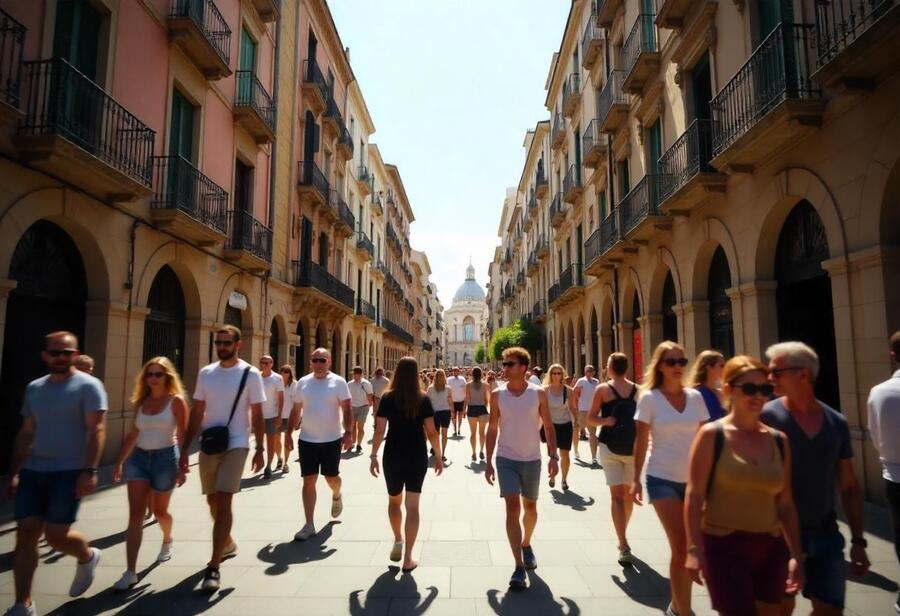≡-France, Spain and Greece Introduce Plans to Manage Tourism and Protect Local Communities, Housing and Culture in Cities Like Venice, Barcelona, Santorini and Florence Across Europe – Viral of Today
<> Viral of Today <>
Home » European Travel News » France, Spain and Greece Introduce Plans to Manage Tourism and Protect Local Communities, Housing and Culture in Cities Like Venice, Barcelona, Santorini and Florence Across Europe Thursday, June 26, 2025As tourism in Europe continues to soar, countries like France, Spain, and Greece are taking proactive steps to manage the growing influx of visitors while ensuring the preservation of their local communities, housing markets, and cultural heritage. With iconic cities such as Venice, Barcelona, Santorini, and Florence facing increasing pressure from overtourism, these nations have introduced strategic plans aimed at balancing economic growth with sustainability. The rising demand for tourism has led to overcrowded streets, soaring housing prices, and the erosion of local culture, prompting these countries to implement measures that will protect their unique identities and improve the quality of life for their residents. By managing tourism in a more regulated and thoughtful way, France, Spain, and Greece aim to safeguard their rich cultural legacies while providing a better experience for both locals and visitors alike.Overcrowding and Housing Crisis Across Iconic CitiesCities across Europe are buckling under the weight of mass tourism. Streets in popular destinations like Barcelona are flooded with tourists, with the once-charming lanes now echoing the sound of rolling suitcases. In Santorini, once quiet pathways are now overwhelmed by crowds, and Venice, famous for its picturesque canals, has introduced an entry fee to manage the influx of visitors.However, it’s not just about crowded streets. For many residents, the surge in tourists is dramatically altering their daily lives. Housing prices in tourist-heavy cities are soaring, as an increasing number of homes are converted into short-term rentals, reducing the availability of affordable housing for locals. Neighborhoods are losing their identity as souvenir shops, luxury boutiques, and cafes catering solely to visitors replace once-thriving local businesses. Residents find themselves being displaced, both economically and culturally, by the rising tide of temporary visitors.Southern Europe Feels the Pressure the MostSouthern European nations like France, Spain, and Greece are particularly affected by the tourism boom. In 2024, France welcomed over 100 million tourists, far surpassing its population of 66 million. Spain followed suit with 94 million foreign visitors, nearly double its population of 49 million. Similarly, Greece witnessed tourist arrivals far exceeding its resident population, placing immense strain on infrastructure and natural resources.This burden is especially heavy on smaller islands. Spain’s Canary and Balearic Islands, with fewer than 5 million residents, hosted more than 30 million visitors combined in 2024. In Venice, the city’s iconic canals have become clogged with gondolas and water taxis, making it challenging to navigate the waterways, which are further congested by cruise ships and local traffic.The impact of this tourism overload is also being felt at major cultural institutions. For instance, workers at the Louvre Museum in Paris have gone on strike, citing the overwhelming pressure of mass tourism, which has strained the museum’s resources.What’s Driving the Surge in Tourism?The explosion in tourism is fueled by several key factors, including cheaper flights, advanced travel planning technologies, and the growing influence of social media, which encourages the pursuit of “bucket-list” destinations. With platforms like AI-powered travel tools and budget airlines making travel more accessible than ever, tourists are flocking to the same iconic locations year-round, often during peak periods.The surge is particularly driven by visitors from the U.S., China, Japan, and the U.K., who are drawn to Europe’s cultural landmarks and scenic destinations.While some leaders view this as an opportunity for growth, they emphasize the importance of managing visitor flows efficiently. AI technologies are being used to regulate crowds, for example, offering tickets for popular attractions in advance to spread out visitors and avoid bottlenecks.Despite these efforts, public sentiment is growing more frustrated. Cities like Florence, Verona, and the Amalfi Coast are becoming so saturated with tourists that the very essence of their charm is under threat, leaving residents feeling overlooked in favor of short-term gain.Government Actions to Address the IssueIn response to the growing concerns surrounding overtourism, governments are taking decisive actions. In Spain, authorities have cracked down on short-term rental services, ordering Airbnb to remove thousands of illegal listings. Barcelona has announced plans to phase out all city-licensed short-term rentals by 2028 to help alleviate the housing crisis and prioritize homes for residents.Greece has implemented a new cruise tax, charging visitors to popular islands like Mykonos up to €20, with lower fees for quieter destinations like Samos. The revenue generated will be directed toward enhancing infrastructure and supporting sustainable practices on overburdened islands.Venice has reintroduced its controversial entry fee, which ranges from €5-€10, depending on the season. Athens is also experimenting with staggered visiting hours at the Acropolis to reduce congestion and improve the visitor experience.Cultural and Economic Ramifications of OvertourismBeyond the immediate economic and housing impacts, overtourism is also reshaping the cultural fabric of Europe’s most beloved destinations. Small, local businesses are being displaced by global chains that cater exclusively to tourists, and traditional markets are giving way to high-end, international retail outlets. As rent prices increase, artists, artisans, and creators are being pushed out of once-vibrant neighborhoods, and the unique cultural atmosphere that initially drew tourists is gradually being lost.The increasing dominance of tourism in these cities is pushing residents to the edge, as they feel that their homes are being turned into mere backdrops for the tourism industry. The rising tide of tourism threatens to erase the local culture and identity that makes these destinations so special in the first place.Shifting Policies for a Sustainable Tourism FutureIn response to the challenges posed by overtourism, governments and city officials across Europe are exploring new policies aimed at balancing the needs of tourists and local communities. Protests, lobbying efforts, and growing public outcry are pushing local authorities to rethink tourism regulations.In some cities, tourists may soon face higher entry fees, stricter scheduling, and more limited accommodation options. Venice’s introduction of an entry fee, the implementation of AI-powered crowd control, and Spain’s crackdown on short-term rentals all suggest that tourism in Europe will become more carefully regulated. The forthcoming European Travel Information and Authorization System (ETIAS) will also require pre-travel authorization, further streamlining visitor flows and reducing the amount of spontaneous travel.Displacement of Migrants and Housing ShortagesThe housing crisis exacerbated by overtourism is not limited to local residents. Migrant workers, who often already face precarious living conditions, are increasingly being pushed out of city centers as rents rise and short-term rentals become more widespread. Cities with high levels of tourism are finding that even migrants, who contribute significantly to local economies, are being forced to move to the outskirts of cities due to the scarcity of affordable housing.This displacement is making it more difficult for migrant workers to maintain stable living conditions, further deepening the socio-economic divide in urban areas.The Path Forward: Smarter Solutions for Sustainable TourismEurope’s tourism boom is testing the limits of its cities, highlighting the need for more sustainable tourism practices. As the continent grapples with rising housing costs, cultural displacement, and environmental concerns, the future of tourism will depend on the implementation of smarter, more sustainable solutions.Governments are beginning to recalibrate their policies, focusing on balancing the interests of residents with the economic benefits of tourism. By using technology to manage tourist flows and investing in infrastructure to support long-term sustainability, Europe can preserve its cultural identity while still welcoming visitors.The future of tourism in Europe will be shaped by the ability to strike a balance between protecting local communities and the industries that support tourism. As travelers and policymakers work together, Europe can set an example for responsible tourism that values both heritage and progress.Tags: Barcelona, Europe, Florence, france, greece, santorini, spain, Tourism news, Travel Destination, travel industry, Venice
This information will surprise you!
See also
- Read until the end to discover everything.
- Important information you need to know.
- Interesting facts and helpful tips.
Conclusion
Did you enjoy the news? Keep following us daily!













